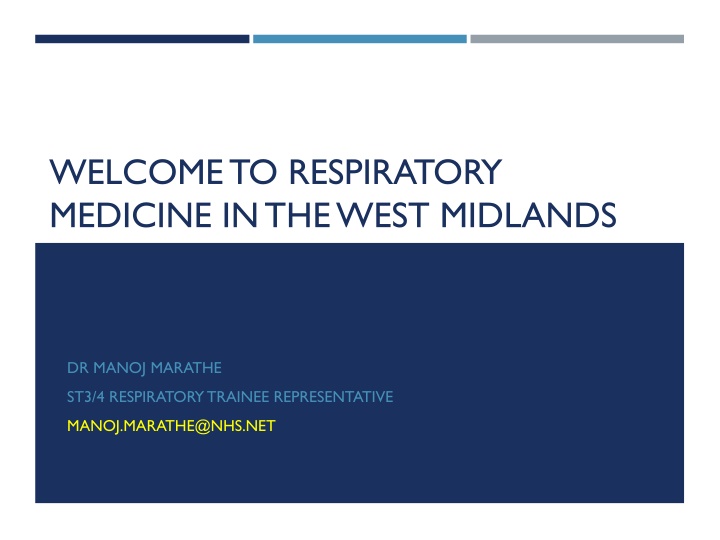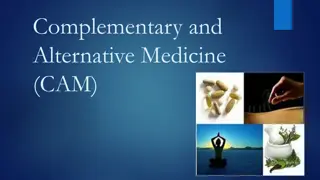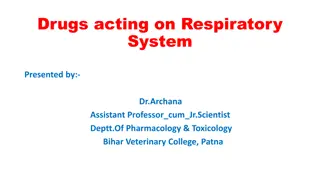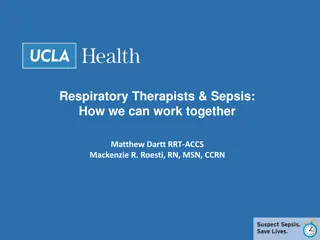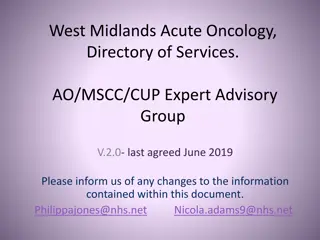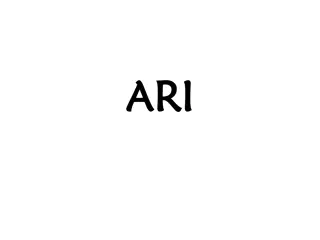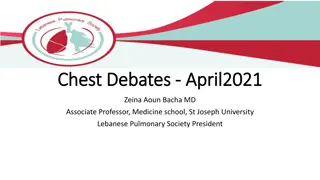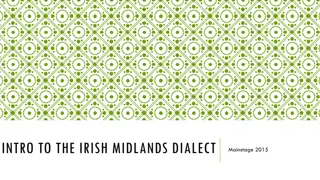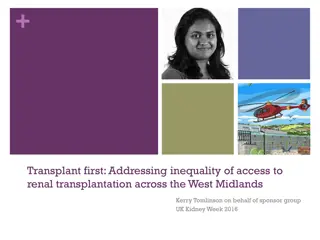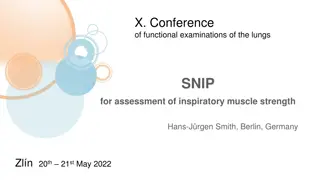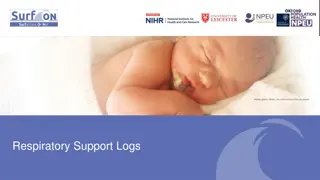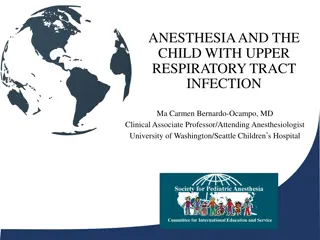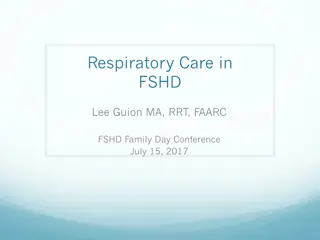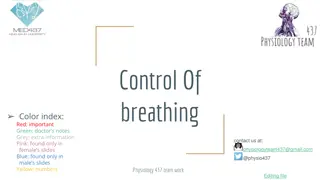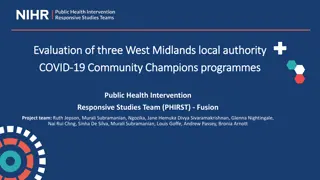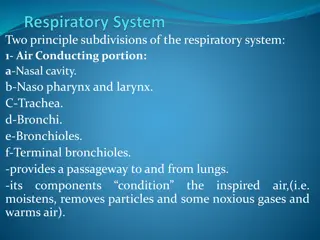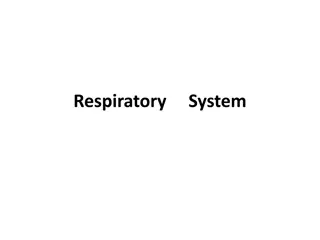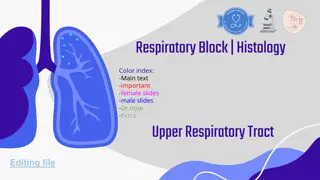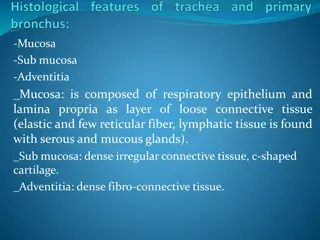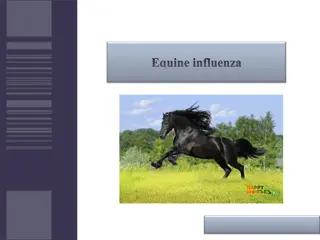Respiratory Medicine Training in West Midlands Deanery
Welcome to the world of Respiratory Medicine in the West Midlands Deanery! This is where you'll find information on the training structure, key personnel, geographical overview, hospital specialties, and the training curriculum. Explore the diverse opportunities offered and learn about the dual accreditation in Respiratory and General Medicine. Discover the various hospitals within the deanery, from Stoke to Coventry, and the vast array of specialties available for training. Get insights into the training structure over five years, including the aim of placements in large teaching hospitals and district general hospitals. Stay informed about requirements, attachments, and opportunities for personalizing your training experience. Dive into this comprehensive guide for respiratory medicine trainees in the West Midlands Deanery.
Download Presentation

Please find below an Image/Link to download the presentation.
The content on the website is provided AS IS for your information and personal use only. It may not be sold, licensed, or shared on other websites without obtaining consent from the author.If you encounter any issues during the download, it is possible that the publisher has removed the file from their server.
You are allowed to download the files provided on this website for personal or commercial use, subject to the condition that they are used lawfully. All files are the property of their respective owners.
The content on the website is provided AS IS for your information and personal use only. It may not be sold, licensed, or shared on other websites without obtaining consent from the author.
E N D
Presentation Transcript
WELCOME TO RESPIRATORY MEDICINE IN THE WEST MIDLANDS DEANERY DR MANOJ MARATHE ST3/4 RESPIRATORY TRAINEE REPRESENTATIVE MANOJ.MARATHE@NHS.NET
INTRODUCTION West Midlands Deanery Structure of training and Respiratory ARCP Communication Organisations Things to do now and Tips
WHO IS WHO Dr.K. Srinivasan Training Programme Director (TPD) & Speciality Training Committee (STC) Chair (Consultant in Telford) Dr.Shiva Bikmalla Chair ST3 / ST4 teaching committee (Consultant in Stoke) Multiple other consultants form STC regular meetings Deborah Gregory Respiratory Admin lead (Stoke) Deborah.Gregory@uhnm.nhs.uk
WHO IS WHO ( CONTD ) Dr.Chris Huntley Trainee rep on the Training Committee Christopher.Huntley@nhs.net Dr.Bhavani Adizie LTFT Trainee rep on the Training Committee janathiagarajah@gmail.com Dr Jude Hampson Midlands Thoracic Society Trainee Representative jude_brebner@hotmail.com Dr.Manoj Marathe ST3/4 Trainee rep on ST3/4 Sub-committee Manoj.Marathe@nhs.net Please ensure that we have your email addresses
GEOGRAPHY Large Deanery UHNM (Stoke) in the North to Coventry in the South Hereford in the West to Warwick in East Vastly diverse population rural and urban ideal for respiratory medicine Excellent culture and large numbers of trainees remain in region on completion of training
SPECIALITIES WITHIN HOSPITAL QEHB transplant, ITU, ILD, Difficult Asthma Heartlands CF, ITU, Difficult Asthma, Sleep Stoke ITU, Sleep, NIV (Domicillary / MND), ILD, Pleural and Intervention, CF New Cross ITU, EBUS Sandwell EBUS, TB Worcester allergy DHG much more scope for bronchoscopy / pleural procedures
STRUCTURE OF THE TRAINING 5 years (before OOP experience) with yearly respARCP Dual accreditation in Respiratory and General ( Internal ) Medicine Deanery Aim for: 2 years in Large Teaching Hospitals (Stoke, QEHB/UHB, Heartlands) 3 years in District General Hospitals National Curriculum requirement is 12 months I/P and O/P in teaching and district (easily obtained) Attachment in ITU during five years Aim for element of choice of placements after ST3 to try and meet personal circumstances, training needs etc (where possible) Submit requests May Final placement known August Rotate Nov
TRAINING ST3 & ST4 ST5 & ST6 GIM training: Structured training programme over first 2 years No fees after finishing ST4 Need to attend regular training days Modules 2 a year where start developing specialist interests Require at least 4 per year 2 year cycle RCP days require payment (~ 50/day) ~ 12 training days/ year (need 70%) Essay/Written report produced at end of module Cover the core areas of the curriculum Can attend other specialty training days Working on new teaching days Modules Updates in medicine Probably 3 times / year 200/ 6 months (can be reclaimed against study budget) costs reviewed regularly and reduced wherever possible Training programme found on MTS
RESPIRATORY ARCP DECISION AID First week of October this year second week. Portfolio needs completion 2 weeks prior Respiratory decision aid on JRCPTB site https://www.jrcptb.org.uk/specialties/respiratory-medicine Respiratory Curriculum on JRCPTB site https://www.jrcptb.org.uk/sites/default/files/2010%20Respiratory%20%28am endments%202014%29.pdf 3.4 clinical experience, 4.1 training programme
ARCP DECISION AID (ST3) History taking, Clinical Examination, Prescribing SOB, Cough, Haemoptysis etc. Asthma, TB, COPD etc. ALS, NIV, Pleural Aspiration, Chest Drain
CF, LUNG TRANSPLANT, PULMONARY VASCULAR DISEASE E12 Pulmonary vascular disease: Ideally short secondment Minimum if not: regional training programme (13th september) + 2 O/P sessions in specialised clinic + 1 CBD E16 CF: Ideally 3 month placement with weekly clinics Minimum if not: regional training programme (available every year) + 2 O/P sessions + 1 CBD + 1 MDT E20: Lung transplant: Ideally short secondment Minimum if not: regional training programme (13th september) + 2 O/P session in specialised clinic + 1 CBD
ARCP DECISION AID CONT. (ST3) DOPS 2 Bronchoscopy, 1 NIV, 1 Pleural USS, 1 Chest drain Bronchoscopy must include x2 safe sedation Lung function and Spirometry - competence / experience confirmed by ES CXR / CT interpretation competence / experience confirmed by ES Procedure Logbook evidence of engagement for ST3 sufficient Audit and Teaching 1 QIP in ST3 or ST4 (1 further QIP in ST6 or ST7) Evidence of teaching DOPS Attendance 70% of teaching days
ARCP (FUTURE) Look at aid to see which DOPS etc need re-doing every year SCE exam recommended in ST5 / ST6 / ST7 Occur annually (Oct / Nov) maximum of 6 attempts Covers guidelines, latest evidence Training days / books Penultimate Year Assessment (PYA) happens around 12 - 18 months before CCT date What needs completing before CCT Out of Programme Placement Research (MD / PhD) / Training (e.g fellowship or chief registrar) / career breaks
LOGBOOKS Link to good log-book (excel) at JRCPTB https://www.jrcptb.org.uk/eportfolio-information/updates-and-performance No patient details! Record hit rate for bronchs (and follow up pleural patients) Need to record everything ST3 ARCP show Satisfactory record with bronch / USS / NIV experience - aid NIV: DOPs ST3 and shows competence curriculum Final ARCP Minimum 100 independent bronchoscopies recorded to be signed off Different competency vs experience only (lavage / transbronchial) required Level 1 pleural ultrasound Competent with NIV
PLEURAL USS Level 1 Sign off by end of ST5 Local supervisors will have slightly different requirements for proof Royal College of Radiologists Focused Ultrasound Training Standards, 2012 Royal college of radiologist Ultrasound training recommendations for medical and surgical specialties Third edition Observe 20 normal Perform 20 normal Perform 20 Pleural effusion Perform 20 thoracocenteses / chest drain
LUNG FUNCTION PORTFOLIO Combination of practical procedures and interpretation Reasons, contra-indications, appropriateness of requests How to identify errors and implications on accuracy Interpretation of results and advice on how to write reports Link via MTS and JRCPTB website download and print out Will need to be completed by end of ST5 To work through with your consultants / physiologist during placements Requires organising local arrangements Can be difficult but if organised in time can be done within 3 years Some changes due For ST3 ARCP Evidence of engagement
LUNG FUNCTION PART A PART C PART B 58 cases 2 Interactive scenarios
PRESENTATION ARCP requirement Case report / research / QIP Submission end of March Presentation middle July Last year clinical error in complex TB management / case report on viral pneumonia All registrars require to submit presentation and attend
MODULES 2 modules at ST5 / ST6 Self selected / directed Literature review / case series / reflection on clinical attachment Explore area of respiratory medicine Allows you to develop a specialty interest Minimum requirement discussion at educational supervisor meeting Coming up presentation at ST5/6 training days
ORGANISATIONS British Thoracic Society recommend becoming members of this Online teaching modules Thorax journal European Respiratory Society - 20 extra if have BTS membership JRCPTB need to enrol to gain access to e-Portfolio Royal College of Physicians if a member get discounts on training days etc Midlands Thoracic Society: http://www.midlandthoracic.co.uk/ At least 2 meetings/year organised by different hospitals Next conference 12th October (Hereford)
USEFUL LINKS/ WEBSITES www.midlandthoracic.co.uk Trainee site currently being update https://respnetlondon.com/ For north West trainees but excellent links to guidelines, resources https://www.brit-thoracic.org.uk/ Good e-learning Audit links Lots of guidelines Excellent courses on NIV / imaging BTS induction information https://www.brit-thoracic.org.uk/document-library/delivery- of-respiratory-care/working-in-the-specialty/trainee-induction-pack-january-2016/
RESOURCES (PERSONAL PREFERENCES) Book Oxford Handbook of Respiratory Medicine Non Invasive Ventilation made simple 2nd edition, William Kinnear Bronchoscopy Youtube video Flexible Fiberoptic Bronchoscopy: Normal Anatomy Federico Venuta Learn anatomy first! Pleural effusions / Pneumothorax BTS Pleural Disease Guideline 2010 BTS / ERS guidelines
COMMUNICATION Trainee representatives Dr Bikmalla / Dr Srinivasan Deborah Gregorary Facebook site (in progress) Whatsapp group Mentor (will get details) Regular socials planned
THINGS TO DO NOW Familiarise yourself with the respiratory and lung function portfolio **JRCPTB aids and curriculum (see above)*** BTS Induction Information Register with JRCPTB Discuss ultrasound level 1 sign off with local supervisor (ST 3 / ST 4) Organise meeting with educational supervisor (useful even if 3 month placement) Contacts, email addresses, groups
TIPS FOR SUCCESS Be organised with portfolio (GIM vs Respiratory) Learn the basics (pleural / bronchoscopy) first Organise local lung function teaching / sessions early Think about presentation early Be prepared and organised for ARCP ( Remember to fill JEST compulsory ) Organise study leave in time Involve yourself with audits / clinical research from the start
GOOD LUCK Any Questions?
